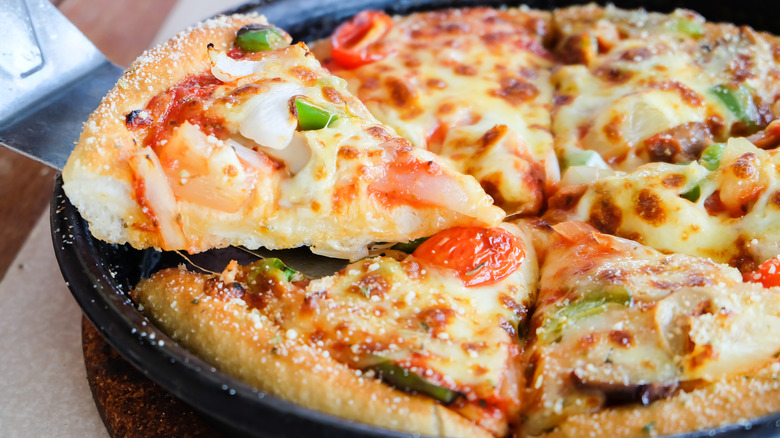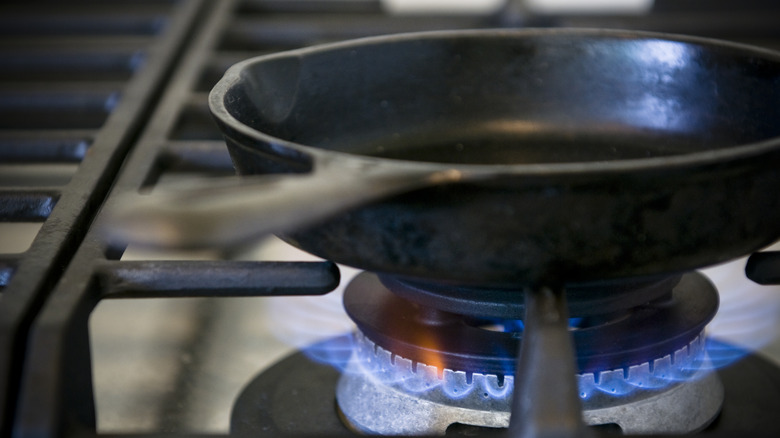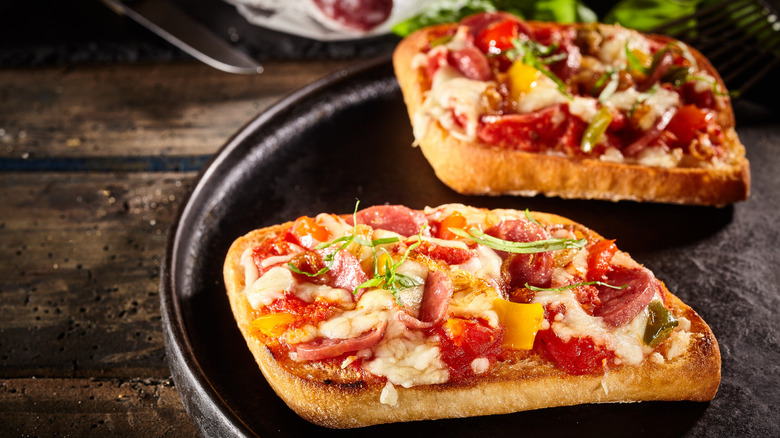The Ideal Pan For Perfectly Reheating Your Pizza
Pizza is one comfort food that is practically made for next-day consumption. And while there's nothing wrong with cold leftover pizza (and many, in fact, claim it as their preferred breakfast), there's nothing like biting into a hot, crispy, gooey slice the next day. But, unfortunately, reheating your pizza doesn't always deliver the most delectable results. Utilizing your microwave to do so — while quick and easy — tends to offer sad, soggy slices that leave your tastebuds less than thrilled. Reheating on a baking pan in the oven can be inconsistent and result in dry slices that are virtually unrecognizable from the delicious pie you consumed only yesterday.
Enter the cast iron skillet. Credited to Abraham Darby, an Englishman who — in the early 1700s — made cast iron cookware more economical to produce and consequently a more common household item, the nearly indestructible modern cast iron skillet is a versatile culinary hero, making itself essential to many home-cooked and restaurant meals, including, yes, reheated pizza. Whether you use your stovetop or your oven, cast iron is the ideal method of reheating pizza due to its ability to maintain an even level of high heat, which you'll need to revive those slices and achieve that cheesy, melty goodness and perfectly crisp crust you enjoyed the first time around.
Reheating your pizza on the stovetop
Achieving delicious reheated pizza in your cast iron skillet is relatively easy; simply place those leftover slices in your skillet and warm them over medium heat, covered with a lid or piece of foil. If your crust is particularly thick, you'll want to consider turning your heat up a little higher to ensure your pizza gets warmed thoroughly. Another tip is to place your slices down completely flat, ensuring that all portions are touching the bottom of the skillet, and leave some room between them — this way, the heat gets evenly distributed, and the whole of your slices become crispy. For the ultimate reheated pizza, consider adding a little water — a few drops to a teaspoon — to the other side of your skillet, away from your pizza. The water will create steam, which will help heat your toppings and re-melt your cheese.
Worried about your pizza sticking to the pan? Don't — generally, cast-iron pans are non-stick, and, because they're typically well-seasoned, there's a natural barrier to keep your pizza from sticking. But you can always add a little cornmeal to the skillet before placing your slices on it for peace of mind. Warm your slices for about six to eight minutes, and you — and your pizza— are golden. But be sure to let it cool down for a few minutes before consuming, so you don't risk that way-too-hot pizza cheese burn that leaves the roof of your mouth beefing with you.
Reheating your pizza in the oven
Alternatively, if reheating using your oven is more your speed, you can do so just as easily. But you'll want to preheat your skillet for this method by simply placing it in your oven, then heating it to about 425 degrees before adding your pizza slices once it has reached the desired temperature. You'll only need to reheat your pizza for about three to six minutes to achieve a crispy crust, but you'll want to keep a close eye on it so it doesn't burn. When your pizza edges are crisp and your cheese is gooey, it's ready to go. But it's important to note that cast iron takes longer to cool down than the average pan, so you'll want to remove those slices from the skillet as soon as possible so they don't burn and you can enjoy that pizza as much as you did when it was fresh.
So, when it comes to warming your leftover pizza slices, go with a cast iron skillet to achieve maximum deliciousness and restore your pizza to its original delectable glory. The good news is that cast iron is effective. The better news is that it's also very easy.


